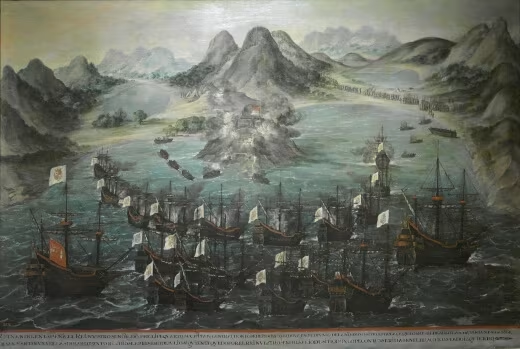Sint Maarten history
1. Once upon a time, over 40 centuries ago,…
Archaeological excavations at Sint Maarten have dated the presence of cultures of Amerindian peoples to 2,000 years before our era. The first migrants to settle on this fertile land are believed to have arrived a millennium later from South America. They were the Arawaks, a semi-nomadic people who lived off the fruits of gathering, hunting, and fishing. The existence of this population was unfortunately put in jeopardy in the year 1400 when the Caribs, anthropophagous warriors, landed on the island. The men would have been decimated, while their widows would have been enslaved by the newcomers. Although several versions of this period diverge, the following facts, written by the first settlers, are worth noting:
- Three languages were used by the local population: one, that of the Arawaks, was spoken by the women. The second one, that of the men, was the result of a mix between the Caribbean and Arawak. The last one was the language only used about warlike activities.
- Artifacts were found that clearly came from two different cultures that were not related. They are essentially two types of pottery whose appearance is clearly distinct, denoting a difference in style.
The arrival in the 16th century of settlers carrying unknown viruses would have wiped out the island's Amerindian population, which was unable to fight the disease.
2. November 11: Saint Martin's Day
Within 24 hours, the island could have been called Saint-Léon or Saint-Josaphat. It is named after Saint Martin, because on 11 November 1493, Saint Martin's Day, the Spanish navigator Christopher Columbus landed there. Now known by freebooters and privateers from all over Europe, the island served as a port of anchorage and became coveted for the existence of its salt deposits. It is thus nicknamed "Soualiga", which means Land of Salt.

© Credit source : Wikipedia.org
The presence of this raw material prompted the Dutch to settle in Saint-Martin in the 17th century to exploit its deposits. As for the French, with their determination to conquer the West Indies, they settled in the north-east of the island to grow tobacco. Although these decisions provoked the ire of the Spaniards in 1638, who occupied the territory militarily in reaction, Spain finally abandoned this land in 1648, which was considered too small.
3- The Treaty of the Mount of Accords
Rather than fight, the French and Dutch intelligently decided to share the sovereignty of Saint-Martin. Thus an agreement was signed on March 23, 1648, bearing the name of Mons Concordia, the mountain where it was concluded: the northern region of 52 km² thus became the property of France, while the southern part of 34 km² became the property of Holland.
Saint Martin splits into Sint Maarten. Article 3 of the Treaty provides "That the French and Dutch who inhabit this island shall live as friends and allies, without any molestation on either side". Article 5 specifies that the natural resources of the whole island are to be pooled and Article 7 provides that the French and Dutch will help each other in the event of an enemy attack. And that is indeed what happened for centuries to resist the numerous attacks by the British navy.
4- Moving towards autonomy
Sint Maarten's particularism sooner or later destined it to become officially self-governing. Since 2007, the French part of the island has been an overseas collectivity (COM), a status that gives it a certain degree of autonomy. Although Saint Martin is part of the European Union, this is not the case for Sint Maarten, which since 2010 has been a member of the Netherlands and therefore not a member of the EU. This evolution of the island as a whole is all the more inevitable as it has set up a very diversified economic system based on tourism. The tourist offer in terms of accommodation, car rentals, and leisure activities is true of high quality.
5- Sint Maarten's economy
The centuries have seen a succession of different agricultural crops in the favorable climate of Sint Maarten: tobacco, indigo, cotton, cocoa, coffee, and sugar cane have in turn contributed to the economic development of the island, in addition to salt production.

© Credit source : image.amuseumnaturalis.com
But in the middle of the 20th century, relying on its proximity to the United States and becoming aware of its wonderful natural heritage, Sint Maarten made a 360-degree turn, focusing most of its income on tourism. Now both sides of Saint Martin's island has many holiday resorts, for high quality stays that make its international reputation. With its water sports, historical monuments, international events, its lively nightlife, and walking activities, the island abound in leisure activities that boost the local economy.
As a result, the mores have become more Americanized on both sides of the symbolic St. Martin border. The two official languages, French and Dutch, have been supplanted by English and the American currency has become the reference. Far from distorting the island, this new presence of American tourists is in line with the tradition of St. Martin, that of land open to the people, welcoming and warm.

Subscribe to our newsletter and receive our best offers of the moment exclusively
CAR RENTAL CATEGORIES
CAR RENTAL LOCATIONS
BEST OF ST MAARTEN


Trip advisor

World Award

Kayak Award
©Europcar St Maarten : Car Rentals
